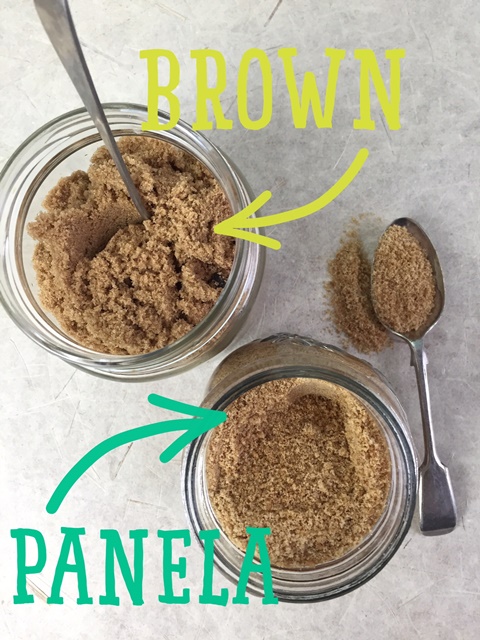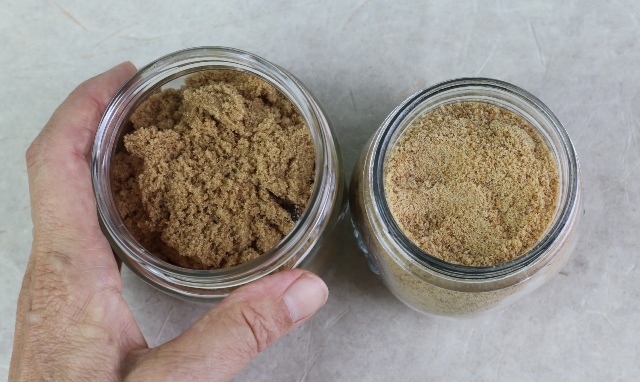What exactly is panela?

I keep hearing about panela and seeing packets of soft brown, sand-like crystals sold in health food stores like About Life in Australia and Whole Foods in the UK. It is marketed as ‘unrefined panela cane sugar’ no doubt to snare us in our quest for all things unrefined, sustainable and more ‘natural’. The term ‘panela’ puzzled me so I’ve done a lot of checking up on it so you can get the facts here, quickly.
What is panela?
For expert guidance, I turned to a recent book called The Ultimate Guide to Sugars and Sweeteners which covers the ins and outs of 185 sugars, syrups and sweeteners. It’s a book I’ve found very sensible on the whole topic of sugar and on whether the notion of quitting sugar entirely is a good one as it’s an issue that can swing to extremism at times. You can read my review of it here.
On page 147 the book says:
“Panela is the most common name for the traditional sugar produced and consumed throughout Latin America and the Caribbean by concentrating freshly extracted cane juice. Most is still made in small-scale, on-farm mills (trapiches) with traditional technology.
“Sugarcane is cut, transported to the mill (in some places still by donkey) and crushed. The juice is filtered and boiled down in open pans to evaporate its water content and make a thick syrup which is traditionally poured into cones, disks or blocks.
“Most panela is granulated - the juice is boiled down and then the syrup is beaten to form free-flowing fine soft golden-brown granules. It’s likely to be organic and Fair-trade too.”
So technically panela is partially-refined, non-centrifugal sugar. The authors call it partially refined to describe the processing aspect and the fact that it hasn’t been additionally processed in a refinery – as most regular sugar has these days.
Evaporated vs centrifuged
On page 132 the book says:
“Regular sugars at the supermarket are centrifugal sugar products meaning that the crystals have been separated from the molasses at the refinery in a machine rather like a spin dryer. Most brown sugar, for example, is simply granulated sugar with a coating of molasses sprayed back on.
“In contrast, the non-centrifugal sugars are those traditional part-processed golden to dark brown sugars that retain their natural molasses content and are brown all the way through. These days, they are often thought of as ‘less processed’ and hence ‘better for you’ when it comes to sugars.
“They include jaggery or gur in Asia, panela in Latin America (also called rapadura in Brazil and dulce in Costa Rica) and muscovado from Mauritius. India is the world’s number one producer while Colombia is second.
“As the term ‘non-centrifugal’ doesn't exactly trip off the tongue, manufacturers tend to describe these first-stage or partially-refined sugars as evaporated cane juice, dehydrated cane juice, whole sugar or unrefined, raw sugar.”
Is panela healthier than regular brown sugar?

You may spot claims such as ‘all natural’ or ‘unrefined’ or ‘organic’ which may be true but that doesn’t means it’s healthier or got less sugar or fewer Calories.
It hasn’t been GI tested by the accepted international method but is likely to have the same moderate GI as ordinary sugar with a GI of 65. According to the Organic Mountain brand of panela, it’s 78 per cent sucrose but with some 4 per cent glucose and 4 per cent fructose and so is similar.
The level of polyphenols and bioactive substances from the cane juice could perhaps push the GI lower but the book says that “until we have the test results, we think it wise to assume to glycemic index is moderate” (p 148).
As with other brown sugars, the molasses content may contribute vitamins and minerals not found in regular granulated white sugar but the amounts are way too small to count towards your recommended daily intake.
The pack may show the mineral content, as the Organic Mountain brand does, but there isn’t a whole lot of extra minerals in it apart from iron* and sodium. This probably occurs because the sugar is not separated from molasses during manufacture. I compared 100 grams of panela with 100 grams of other, similar, foods and found that you can get more minerals more easily from fruits, vegetables, juices, lean meats, nuts or whole grains. See my comparisons below:
| Mineral |
In 100 grams of panela |
In 100 grams of |
| Potassium | 11.5 mg | Dried apricots - 1510 mg |
| Banana - 140 mg | ||
| Orange juice, home-squeezed - 151 mg | ||
| Yoghurt, natural, full-fat - 274 mg | ||
| Calcium | 70 mg | Cheddar cheese - 763 mg |
| Almonds, skin on - 250 mg | ||
| Yoghurt, natural, full-fat - 193 mg | ||
| Magnesium | 80 mg | Sunflower seeds - 340 mg |
| Almonds, skin on - 260 mg | ||
| Peanuts, raw - 180 mg | ||
| Dark chocolate - 120 mg | ||
| Iron | 12 mg* | Raw parsley - 11.5 mg |
| Cocoa powder - 16 mg | ||
| All-Bran, fortified - 11 mg | ||
| Sodium | 25 mg | Brown sugar - 21 mg |
| Dates - 14 mg | ||
| Honey - 20 mg |
Source: Panela from Organic Mountain pack 500 g; Foods from NUTTAB FSANZ 2010
* not separated from the molasses




